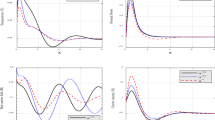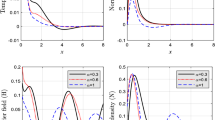Abstract
In the present article, the wave propagation in a homogeneous semi-infinite silicon plate through photo-thermal process has been comparatively studied under the light of memory-dependent thermoelasticity theories with thermal relaxations. Without neglecting the coupling between the plasma and thermoelastic waves that photo-generated through intensity modulated beam of non-Gaussian laser pulse, a two-dimensional semiconducting medium having homogeneity in thermal and elastic properties is considered. The analytical solutions were observed in the domain of Laplace–Fourier transform by the method of eigenvalues approach. Finally, suitable graphical discussions and conclusions are presented with respect to varied thermal relaxation times.











Similar content being viewed by others
References
H.W. Lord, Y. Shulman, A generalized dynamical theory of thermoelasticity. J. Mech. Phys. Solids 15(5), 299–309 (1967)
A.E. Green, K.A. Lindsay, Thermoelasticity. J. Elast. 2(1), 1–7 (1972)
J.-L. Wang, H.-F. Li, Surpassing the fractional derivative: concept of the memory-dependent derivative. Comput. Math. Appl. 62(3), 1562–1567 (2011)
M.A. Ezzat, A. El-Karamany, A. El-Bary, Modeling of memory-dependent derivative in generalized thermoelasticity. The European Physical Journal Plus 131(10), 372 (2016)
A. El-Karamany, M.A. Ezzat, Thermoelastic diffusion with memory-dependent derivative. J. Therm. Stresses 39(9), 1035–1050 (2016)
M.A. Ezzat, A.S. El-Karamany, A.A. El-Bary, On dual-phase-lag thermoelasticity theory with memory-dependent derivative. Mech. Adv. Mater. Struct. 24(11), 908–916 (2017)
S. Shaw, B. Mukhopadhyay, A discontinuity analysis of generalized thermoelasticity theory with memory-dependent derivatives. Acta Mech. 228(7), 2675–2689 (2017)
S. Shaw, Theory of generalized thermoelasticity with memory-dependent derivatives. J. Eng. Mech. 145(3), 04019003 (2019)
Y. Li, T. He, A generalized thermoelastic diffusion problem with memory-dependent derivative. Math. Mech. Solids 24(5), 1438–1462 (2019)
S. Banerjee, S. Shaw, B. Mukhopadhyay, Memory response on thermal wave propagation emanating from a cavity in an unbounded elastic solid. J. Therm. Stresses 42(2), 294–311 (2019)
S. Banerjee, S. Shaw, B. Mukhopadhyay, Memory response on thermoelastic deformation in a solid half-space with a cylindrical hole. Mech. Based Des. Struct. Mach. (2019) https://doi.org/10.1080/15397734.2019.1686989
S. Banerjee, S. Shaw, B. Mukhopadhyay, Thermal memory response in magneto-thermoelastic medium having long cylindrical cavity. WSEAS Transactions on Circuits and Systems 19(1), 1–12 (2020)
I.A. Abbas, M. Marin, Analytical solution of thermoelastic interaction in a half-space by pulsed laser heating. Physica E-Low-Dimen. Syst. Nanostruct. 87, 254–260 (2017)
A. Hobiny, I. Abbas, Analytical solutions of photo-thermo-elastic waves in a non-homogenous semiconducting material. Results Phys. 10, 385–390 (2018)
F.S. Alzahrani, I.A. Abbas, Photo-thermoelastic interactions in a 2d semiconducting medium. Eur. Phys. J. Plus 133, 1–17 (2018)
F.S. Alzahrani, I.A. Abbas, Photo-thermoelastic interactions in a 2d semiconducting medium. Results Phys. 15, 505 (2018)
A. Hobiny, I. Abbas, Generalized thermoelastic interaction in a two-dimensional porous medium under dual phase lag model. Int. J. Numer. Methods Heat Fluid Flow 30, 4865–4881 (2020)
W. Nowacki, Thermoelasticity (Pergamon Press, Oxford, 1986)
D.M. Todorovic, Plasma, thermal, and elastic waves in semiconductors. Rev. Sci. Instrum. 74, 582–585 (2003)
D.M. Todorovic, Plasmaelastic and thermoelastic waves in semiconductors. J. Phys. IV 125, 551–555 (2005)
G. Honig, U. Hirdes, A method for the numerical inversion of laplace transforms. J. Comput. Appl. Math. 10, 113–132 (1984)
Y. Song, D.M. Todorovic, B. Cretin, P. Vairac, J. Xu, J. Bai, Bending of semiconducting cantilevers under photothermal excitation. Int. J. Thermophys. 35, 305–319 (2014)
Author information
Authors and Affiliations
Corresponding author
Appendix
Appendix
1.1 Memory-dependent derivatives
Wang and Li [3] defined memory-dependent derivatives (MDDs) in an integral form with a kernel function on a slipping interval as follows:
where \(\omega \) is the time delay and \(K(t-\omega )\) is the kernel function.
The kernel function should be chosen in such a way such that the magnitude of MDD should be smaller than that of the common partial derivative, and for that the bounds of the kernel should be \(0\le k(t-\xi )\le 1\) for \(\xi \in [t-\omega ,t]\). This is done to educe the memory effect better than others. The time delay \(\omega (>0)\) should always be chosen in such a manner, that the material’s thermodynamical behaviour can be understood more properly.
It is to note that in case \(k(t-\xi )=1\) we shall obtain
This implies that as \(\omega \rightarrow 0\), MDD tends to common partial derivative of first order. The kernel shows a monotone nature with \(K=0\) for the past time \(t-\xi \) and \(K=1\) for the present time t.
During the year 2017, Ezzat and his co-workers [6] have proposed a form of the memory kernel, which is as follows:
a and b are the parameters, the values of which are to be chosen.
The Laplace transform of a function containing the MDD with a kernel of the form (79) is:
If the kernel function \(k(t,p)=1\), then
where \({\overline{f}}(s)\) denotes the Laplace transform of f(t) and \(f(t-\omega )=0\) for \(t<\omega \).
1.2 Non-Gaussian laser pulse function
The temporal profile of a non-Gaussian laser pulse is defined as
where \(L_0\) is the laser intensity that is defined as the total energy carried by a laser pulse per unit area of the laser beam, and \(t_p\) is the characteristic time of the laser pulse which may also be referred as the time duration of the laser pulse.
The function has the property
and
The following figure provides the temporal profile of the laser power \(L_P/L_0\), by considering \(tp = 2p\) s (Fig. 12).
The Laplace transform of Eq. (82) can be easily obtained by using the first shifting property of the transform.
The Laplace transform followed by the Fourier transform of the non-Gaussian laser pulse function is obtained as:
Rights and permissions
About this article
Cite this article
Banerjee, S., Shaw, S. & Mukhopadhyay, B. Non-Gaussian laser pulse response on photo-thermoelastic interactions in a silicon plate under the light of memory-dependent thermoelasticity theory . Eur. Phys. J. Plus 135, 876 (2020). https://doi.org/10.1140/epjp/s13360-020-00887-7
Received:
Accepted:
Published:
DOI: https://doi.org/10.1140/epjp/s13360-020-00887-7





